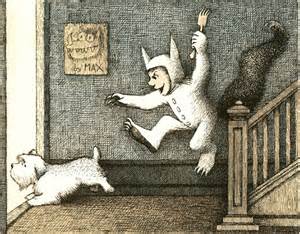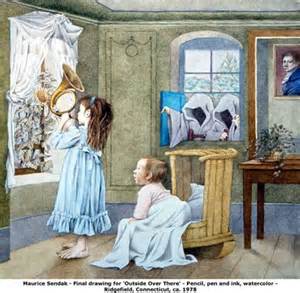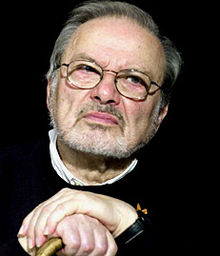I first encountered the Latin phrase Ave Atque Vale in a historical novel whose appeal (the novel’s, that is) was almost entirely nostalgic. It means “hail and farewell,” a way of saluting the past while at the same time leaving it behind. A valedictory is a farewell address, and right about now high schools and colleges are determining which high-achieving student will honored as valedictorian at graduation. For a children’s writer, nothing could be more appropriate as a valedictory than his or her final book—which, whether they intended it or not, will hold between its covers a touch of sadness and regret. Last year three pioneers in children’s literature passed on: Maurice Sendak, Russell Hoban, and Jean Craighead George—and all authored books that were published posthumously. Many adult readers of today grew up with Max with in his Wolf Suit, Mickey in the Night Kitchen, Frances the Badger, Julie (of the Wolves), and Sam (on his Side of the Mountain). Whether or not you were a fan of the author, when picking up one of these posthumous titles you can’t help thinking, This is the last book by_____. There will never be another. In later weeks I’ll 

My Brother’s Book, by Maurice Sendak. HarperCollins, 2013, 31 pages. Age/interest level: 15-up.
Even for a reader who knew nothing of Sendak or his death last year, a haze of sadness hangs over this book. “I cry a lot because I miss people,” he said in one of his last interviews. “They die, and I can’t stop them. They leave me, and I love them more.” Sendak characterized his childhood as “a terrible situation, haunted by the ghosts of extended family members who were slaughtered in the holocaust.” That, and chronic sickliness all through his growing-up years, tinged much of his work with morbidity and foreboding, from Pierre Who Didn’t Care to resentful Ida of Outside Over There. In his economy, love comes with a price tag and an expiration date.
I first encountered Sendak as a child, in the Nutshell Library (where resides Pierre) and a series of humorous etiquette books called What Do You Do, Dear? His heavy lines and dark-haired, serious children were unmistakable years later when I read Where the Wild Things Are to my children. (They loved it, which is why I can still recite pages by heart. 

When his brother Jack (a children’s author in his own right), died in 1995, Sendak wanted to w

It’s not a children’s book. My local library placed it in the literature section (DD 811), which seems appropriate. It’s a poem–not a catchy rhyme, but demanding and often poignant, with William Blake-inspired watercolors from which an occasional Max or Mickey face peers out. The conjunction of the human and the celestial, also characteristic of Blake, shines out from the first page:
On a bleak midwinter’s night/ The newest star! –blazing light!/ So crystal bright! –eclipsing the moon,/ Scorching the sky,/ Smashed! –and heaved the iron earth in two.”
As I said, not for the kiddoes. The crash of a star into the earth separates brothers Jack and Guy, banishing the former to the icy underworld and grieving Guy to a battle of wits with a bear. One echo jumped out at me, from Chicken Soup with Rice (which I read to my kids over and over): In February it will be my snowghost’s anniversary. Besides Blake, there are very strong echoes of Shakespeare’s The Winter’s Tale, with its death-to-rebirth, sorrow-to-singing theme and, of course, its enigmatic bear. The poem ends happily, in a sense:
And Jack slept safe./ Enfolded in his brother’s arms./ And Guy whispered, “Good night./ And you will dream of me.”


Next week, some words about Russell Hoban. I compare Where the Wild Things Are to another picture book, here.
Stay Up to Date!
Get the information you need to make wise choices about books for your children and teens.
Our weekly newsletter includes our latest reviews, related links from around the web, a featured book list, book trivia, and more. We never sell your information. You may unsubscribe at any time.
Support our writers and help keep Redeemed Reader ad-free by joining the Redeemed Reader Fellowship.
Stay Up to Date!
Get the information you need to make wise choices about books for your children and teens.
Our weekly newsletter includes our latest reviews, related links from around the web, a featured book list, book trivia, and more. We never sell your information. You may unsubscribe at any time.
FREE Bible Guide!
Get a guide to the Best Bibles for Children and Teens. Perfect for an Easter gift.
We'd love to hear from you!
Our comments are now limited to our members (both Silver and Golden Key). Members, you just need to log in with your normal log-in credentials!
Not a member yet? You can join the Silver Key ($2.99/month) for a free 2-week trial. Cancel at any time. Find out more about membership here.
5 Comments
Leave a Comment
You must be logged in to post a comment.


… erm… Should be “hail and farewell.” A person might be “hale and hearty.” Hail is a verb; hale is an adjective. Sorry, grammar teacher and text editor, just can’t switch it off!
Thanks, Kathy! I actually spent some time debating that with myself–should have just looked it up!
Could we do a podcast of Janie reciting Where the Wild Things Are? With sound effects? 🙂
Megan: I can only do it when flanked by a 4 year-old and a 2 year-old. Must have appreciative audience!
And although I admire the gorgeous, complex artwork in Outside Over There, it is indeed haunting and melancholy, even with a happy ending. I wish I could love it.